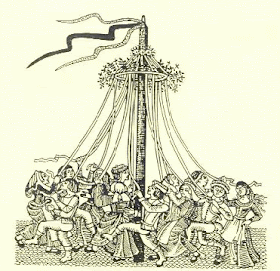Summer is birthday season in our house: not only this blog, but five of the six people living in our house have summer birthdays. And lots of birthdays mean lots of cakes. In honor of which, this month I’m serving up linguistic trivia relating to that most iconic of desserts.
cake - Entering English from Old Norse, the word originally denoted any sort of roundish cooked dough, usually more bready than sweet. (We can still talk of crab cakes and cakes of soap, for example). Only in the fifteenth century did sweetness become a standard part of the definition. Although cake has cognates in the Germanic languages, the Romance languages don’t share cognate words. French is gâteau, Italian is torta, and Spanish is pastel, the first two of which, at least, English has borrowed, because you can never have too many ways to talk about cake.
icing on the cake - The icing on the cake literally appeared in the eighteenth century with the growing of sugarcane in European colonies, but the idiom meaning "a crowning benefit added to something already good" is apparently from the mid-twentieth century. In a touch of irony, no one in our family likes icing very much, and we often end up scraping the icing off the cake! Or, of course, not putting it on our birthday cakes in the first place. (We don’t much like maraschino cherries on top, either, ruining that synonymous dessert idiom, as well.)
a piece of cake - The OED lists the first use of this idiom to 1936 (coming after its synonymous dessert idiom easy as pie from 1913). Our family have been enjoying “The Great British Bake Off” recently, which certainly aims to prove that making a piece of cake or a pie is not necessarily easy. It’s the eating that’s no problem at all.
to have one’s cake and eat it, too - One of my most-used idioms (although I more commonly say “You can’t have it both ways”), this one is intended to indicate the impossibility of having and eating simultaneously rather than consecutively. Its first recorded use in English is in John Heywood’s collection of proverbs from 1562.
Let them eat cake! - Popularly attributed to French queen Marie Antoinette as evidence of her cluelessness and insensitivity toward the common people’s troubles, the same words had also been attributed to various other princesses and nobility. Most notably Jean-Jacques Rousseau mentioned this phrase as being spoken by “a great princess” at least a century before Marie Antoinette was to have said it. (In the original French, by the way, it isn’t cake anyway but brioche. But if you don’t have bread or brioche? In that case, by all means eat cake!)
[Pictures: Birthday cake card, linocut by Heather Smith (Image from her Etsy shop Cosmikgoo);
Marie-Antoinette, engraving, I can’t figure out a date (Image from Bibliotheque nationale de France).]
















